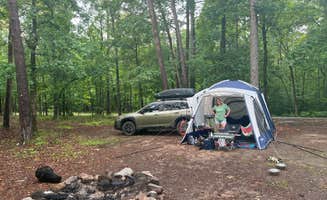Dispersed camping near Mount Hope, Alabama centers on several primitive sites within the Bankhead National Forest area. Located in the foothills of the Appalachian Mountains with elevations ranging from 500-1200 feet, this region experiences hot, humid summers and mild winters. Seasonal variations affect site accessibility, with some forest roads becoming challenging after heavy rainfall, particularly in spring when the area receives an average of 5 inches of precipitation monthly.
What to do
Hiking opportunities: The primitive camping areas near Wolf Pen Hunters Camp provide direct access to numerous wilderness trails. "The hiking in this area is incredible and makes you feel like you are in another world. We have taken several trips to this area and it is well worth it," notes camper Asher K. Forest service maps are recommended as cell service is unreliable for navigation.
Stargazing sessions: Clear night skies offer exceptional views of constellations from most campsites. At Boondock Dispersed Camping Alabama, one camper shared, "The stars were incredible after the moon went down a bit." Light pollution is minimal at most sites, especially at the more remote third site at Boondock.
River access: Multiple camping areas provide water access for fishing or kayaking. The concrete overlook at Blue Creek Public Use Area offers views above the water, with one visitor noting it "gives you a slight breeze for 85 degrees in mid June." The boat ramp facilitates easy water access for small watercraft.
What campers like
Privacy and spacing: Campers consistently mention the ample room between sites. "Sites are spread out and pretty private," reports Sam O. about Wolf Pen Hunters Camp. The gradual layout of sites at Boondock Dispersed Camping allows campers to choose their preferred level of seclusion.
Wildlife encounters: The natural forest setting provides opportunities for animal observation. According to Charles at Boondock Dispersed Camping, "We loved it because there was no chance of hearing any cars and the animal noises were fantastic." Dawn and dusk offer the best viewing opportunities, with fox sightings reported by multiple campers.
Cooling river breezes: During summer months, riverside sites provide natural temperature regulation. Ken H. appreciated that the "large area overlooking the river gives you a slight breeze for 85 degrees in mid June," making the bluff sites at Blue Creek particularly valuable during warmer seasons.
What you should know
Site selection timing: Arriving early improves chances of securing preferred spots. "If you can get there quick enough there are some pretty good spots to camp and it's free," advises Timothy K. about McDougal Hunt Camp, noting proximity to hiking trails.
Road conditions: Forest service roads to primitive sites may require higher clearance vehicles, especially after rain. Sam O. found Wolf Pen sites to be "a little muddy but it had been raining," while another camper noted that at Boondock Dispersed, "the last spot at the end was all muddy" following rainfall.
Fire preparation: Existing fire rings at most sites may need improvement. At Boondock Dispersed, campers reported, "We had to improve the fire ring a bit. Plenty of kindling around." Bringing tools to safely modify existing rings is recommended during fire-permitted seasons.
Cell coverage limitations: Service varies significantly between sites. Rae W. reported "ended up having a little cell reception with T Mobile" at Boondock Dispersed, but coverage is generally unreliable throughout the forest camping areas.
Tips for camping with families
Bug protection: Insect activity increases during warmer months. One camper at Boondock emphasized, "We were glad to have a bug net — probably a necessity for this site!" Bringing both personal protection and tent screens is strongly recommended for summer camping with children.
Supply planning: No services exist at or near most primitive sites. "Closest stores are in Moulton," notes Rhea B., making thorough packing essential for family trips. Creating a checklist with children before departure helps avoid forgotten necessities.
Site selection strategy: For families with young children, consider proximity to the entrance road. The first site at Blue Creek Park offers easier access while remaining relatively private, with Adam D. noting it "felt very private only had 2 or 3 cars come by but everything was very low key."
Tips from RVers
Size limitations: Most dispersed sites accommodate smaller rigs only. While Blue Creek can handle some larger vehicles with one camper noting "some folks also pull RV down to an area near the boat ramp," most forest sites are better suited to compact setups. Class B vans and truck campers navigate the narrow forest roads more successfully.
Leveling requirements: Bring substantial leveling equipment for uneven terrain. Sam O. found sites at Wolf Pen to be "level and clear," but conditions vary seasonally and by specific site location. Multiple leveling blocks and a portable level are recommended.
Turn-around considerations: Forest road camping requires advance planning for parking and exit strategies. The third site at Boondock is described as "nestled in a nice culdesac area," providing easier turn-around options than some mid-road sites that may require backing out.




